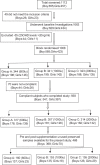Effect of Vitamin D Supplementation on Bone Turnover Markers in Children and Adolescents from North India
- PMID: 31016149
- PMCID: PMC6446672
- DOI: 10.4103/ijem.IJEM_149_18
Effect of Vitamin D Supplementation on Bone Turnover Markers in Children and Adolescents from North India
Abstract
Objectives: Vitamin D is known to play an important role in bone mineral metabolism. Its deficiency may affect growth and status of bone markers in children. Hence, we undertook to study the status of bone markers in children with vitamin D deficiency (VDD) and impact of vitamin D3 supplementation on them.
Materials and methods: Total 468 out of 615 children and adolescents with VDD, who were given either of the three doses (600, 1000, and 2000) of vitamin D supplementation, were included in the study. These 468 children with pre- and postsupplementation preserved samples with available anthropometry, serum biochemistry, 25-hydroxy-vitamin D, and parathormone were evaluated for bone formation (procollagen type 1 amino-terminal propeptide [P1NP]) and resorption (β-cross laps [CTx]) markers.
Results: The mean age and body mass index of these children were 11.3 ± 2.3 years (boys: 11.5 ± 2.4; girls: 12.2 ± 1.2 years; P = 0.03) and 18.1 ± 3.8 kg/m2 (boys: 18.2 ± 3.9; girls: 17.6 ± 3.2 kg/m2; P = 0.208), respectively. There were 8.8% subjects with severe, 42.7% with moderate, and 48.5% with mild VDD. There was a significant decline in serum P1NP (from 691 ± 233 ng/ml to 640 ± 259 ng/ml, P < 0.001) and CTx (from 1.67 ± 0.53 ng/ml to 1.39 ± 0.51 ng/ml, P < 0.001) following supplementation. Though decline in serum P1NP and CTx levels was observed in both boys and girls, among all three supplementation groups and VDD categories, the effect was more marked in serum CTx than P1NP levels.
Conclusions: Vitamin D supplementation in VDD children resulted in decrease in both bone formation (P1NP) and resorption (CTx). The impact, however, was more marked on bone resorption than bone formation.
Keywords: bone markers; parathormone; procollagen type-1 amino-terminal propeptide; serum 25OHD; vitamin D deficiency; β-Cross laps.
Conflict of interest statement
There are no conflicts of interest.
Figures
Similar articles
-
Bone turnover markers, and growth and bone parameters in infants participating in a vitamin D intervention study.Endocr Connect. 2024 Dec 20;14(1):e240482. doi: 10.1530/EC-24-0482. Print 2025 Jan 1. Endocr Connect. 2024. PMID: 39555588 Free PMC article.
-
Effect of vitamin D3-supplementation on bone markers (serum P1NP and CTX): A randomized, double blinded, placebo controlled trial among healthy immigrants living in Norway.Bone Rep. 2015 May 21;2:82-88. doi: 10.1016/j.bonr.2015.05.004. eCollection 2015 Jun. Bone Rep. 2015. PMID: 28377958 Free PMC article.
-
Effect of isolated vitamin D supplementation on bone turnover markers in younger postmenopausal women: a randomized, double-blind, placebo-controlled trial.Osteoporos Int. 2018 May;29(5):1125-1133. doi: 10.1007/s00198-018-4395-y. Epub 2018 Feb 15. Osteoporos Int. 2018. PMID: 29450585 Clinical Trial.
-
The intestinal calcistat.Indian J Endocrinol Metab. 2013 Oct;17(Suppl 1):S25-8. doi: 10.4103/2230-8210.119497. Indian J Endocrinol Metab. 2013. PMID: 24251176 Free PMC article. Review.
-
P1NP and β-CTX-1 Responses to a Prolonged, Continuous Running Bout in Young Healthy Adult Males: A Systematic Review with Individual Participant Data Meta-analysis.Sports Med Open. 2023 Sep 19;9(1):85. doi: 10.1186/s40798-023-00628-x. Sports Med Open. 2023. PMID: 37725246 Free PMC article.
Cited by
-
Discordant responses of bone formation and absorption markers in Japanese infants with vitamin D deficiency: a comprehensive matched case-control study.JBMR Plus. 2024 Mar 18;8(5):ziae033. doi: 10.1093/jbmrpl/ziae033. eCollection 2024 May. JBMR Plus. 2024. PMID: 38623484 Free PMC article.
-
Effect of Vitamin D Levels on Bone Remodeling in Healthy Women.Int J Endocrinol Metab. 2020 May 2;18(2):e100656. doi: 10.5812/ijem.100656. eCollection 2020 Apr. Int J Endocrinol Metab. 2020. PMID: 32636886 Free PMC article.
-
Bone Mineral Density in Children and Adolescents of the Abay Region, Kazakhstan: Prevalence and Associated Risk Factors.Int J Environ Res Public Health. 2025 Jun 17;22(6):949. doi: 10.3390/ijerph22060949. Int J Environ Res Public Health. 2025. PMID: 40566375 Free PMC article.
-
FSH may mediate the association between HbA1c and bone turnover markers in postmenopausal women with type 2 diabetes.J Bone Miner Metab. 2022 May;40(3):468-477. doi: 10.1007/s00774-021-01301-7. Epub 2022 Jan 21. J Bone Miner Metab. 2022. PMID: 35059887
-
Interventions to improve vitamin and mineral inadequacies among children in India: a scoping review.J Hum Nutr Diet. 2025 Feb;38(1):e13384. doi: 10.1111/jhn.13384. Epub 2024 Nov 5. J Hum Nutr Diet. 2025. PMID: 39498573 Free PMC article.
References
-
- Cheng L. The convergence of two epidemics: Vitamin D deficiency in obese school-aged children. J Pediatr Nurs. 2018;38:20–6. - PubMed
-
- Puri S, Marwaha RK, Agarwal N, Tandon N, Agarwal R, Grewal K, et al. Vitamin D status of apparently healthy schoolgirls from two different socioeconomic strata in Delhi: Relation to nutrition and lifestyle. Br J Nutr. 2008;99:876–82. - PubMed



